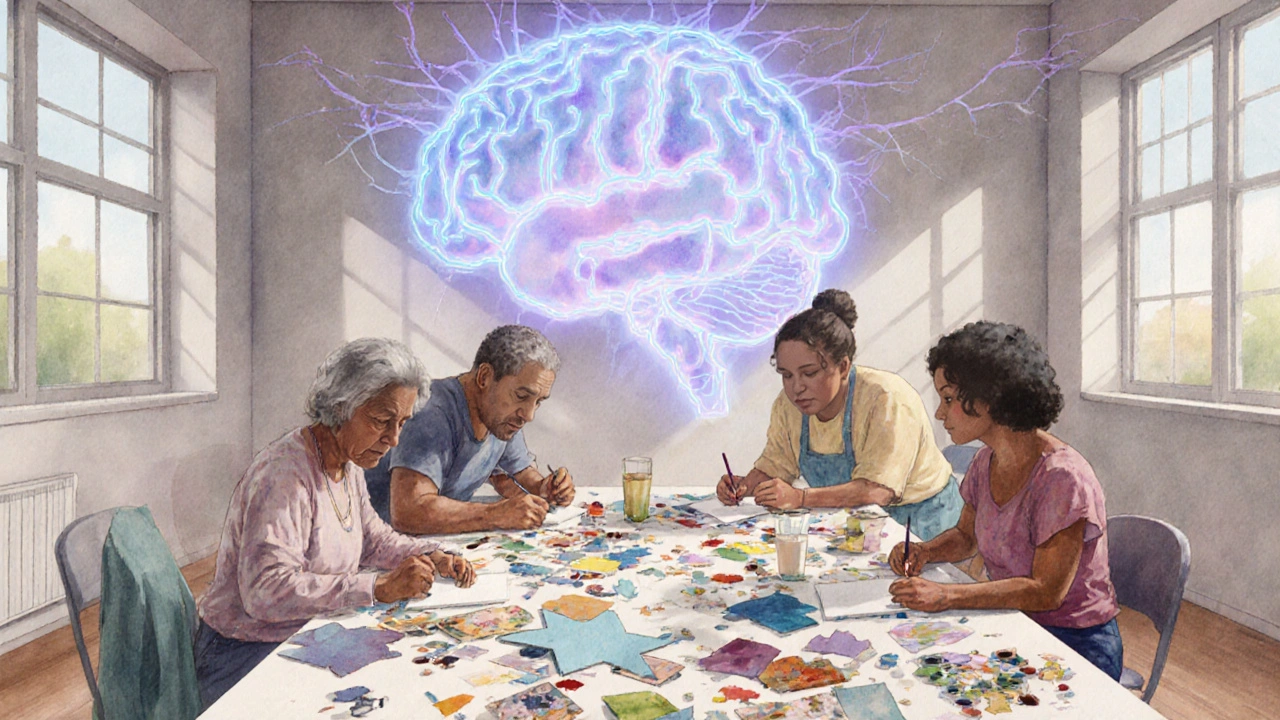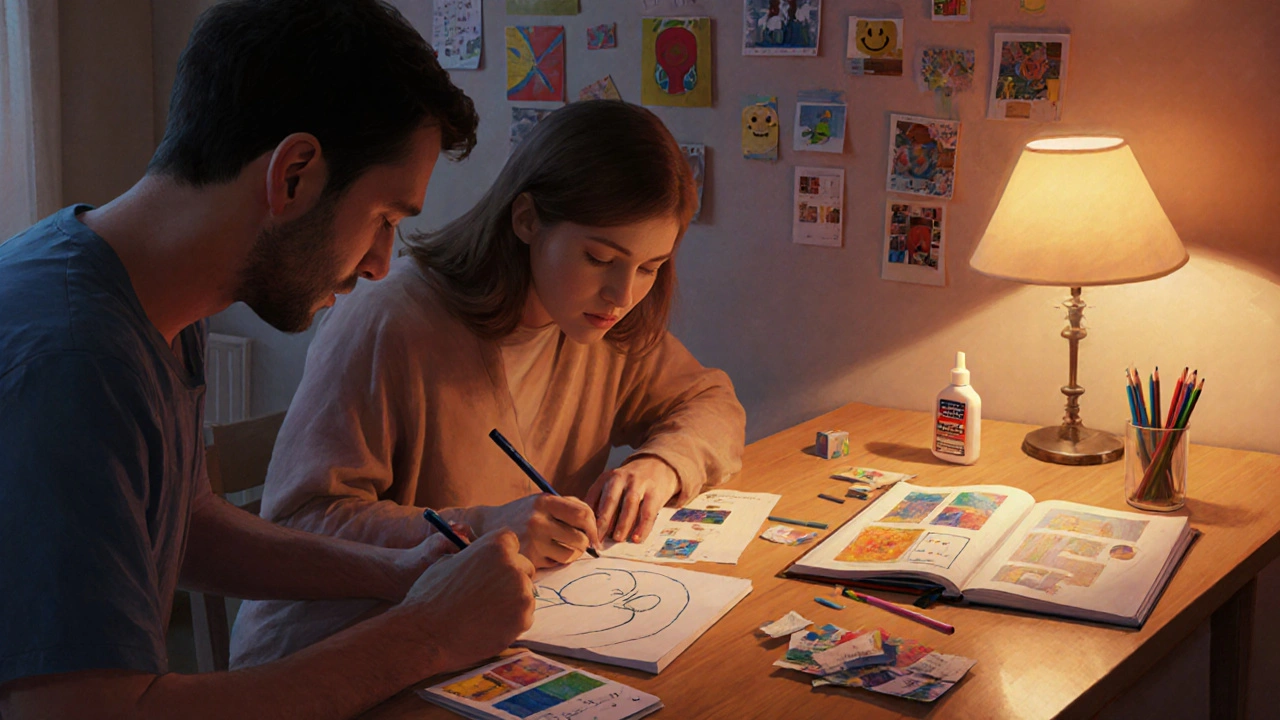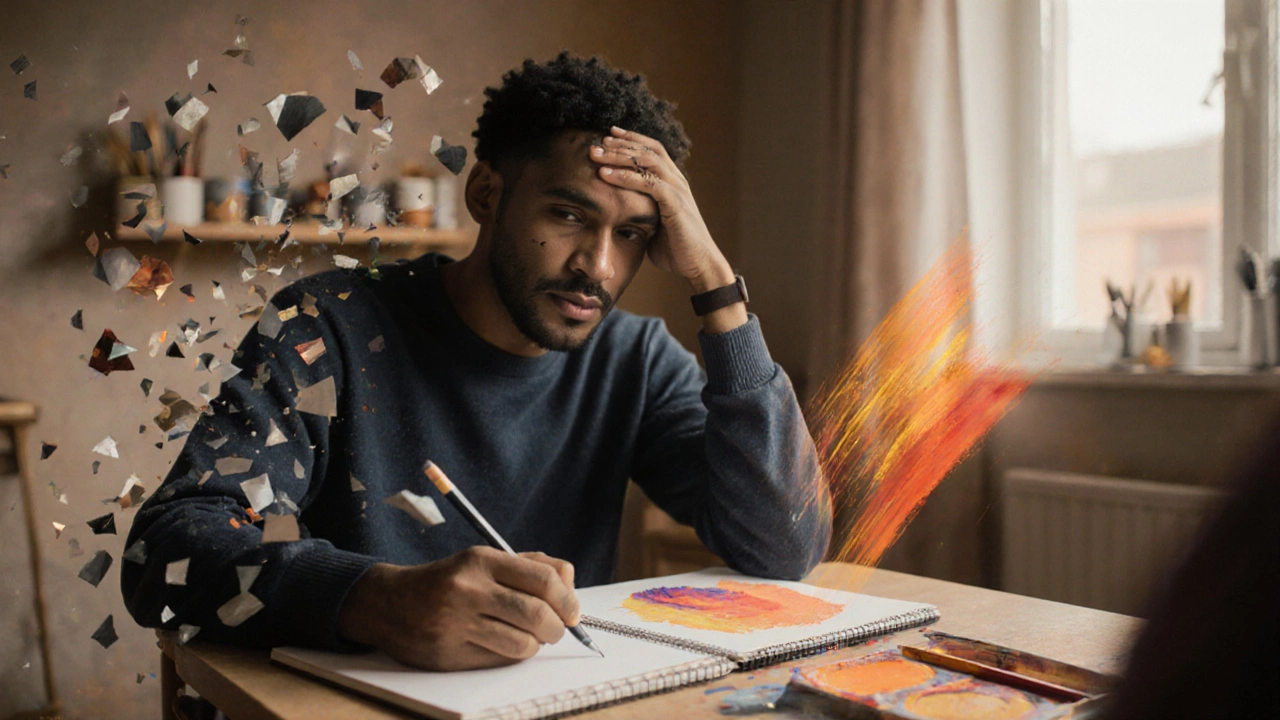Schizophrenia Recovery Progress Tracker
About This Tool
This interactive tracker helps visualize how incorporating art therapy into schizophrenia treatment might lead to measurable improvements in symptoms and quality of life.
Projected Improvements
Estimated Symptom Reduction:
Improved Social Skills:
Reduced Hospitalization Risk:
Based on research showing up to 30% reduction in hospitalization rates and 12% improvement in PANSS scores with structured art therapy.
Key Takeaways
- Art therapy offers a non‑verbal outlet that can lower psychotic symptoms and improve social skills.
- Neuroplastic changes observed in brain imaging link creative expression to better cognitive functioning.
- Randomized trials show a 20‑30% reduction in hospitalization rates when art therapy is added to medication.
- Integration steps include assessment, selecting a qualified facilitator, and tailoring activities to each stage of recovery.
- Common pitfalls - unrealistic expectations, lack of structure, and ignoring cultural preferences - can be avoided with clear goals.
When a person diagnosed with schizophrenia hears the word "therapy," medication and talk‑based approaches usually come to mind. Yet a growing body of research shows that art therapy is a structured, creative process led by trained professionals that uses visual art, music, drama, or movement to promote psychological healing. For many, it becomes a bridge between the fragmented thoughts of psychosis and a sense of agency.
What Exactly Is Art Therapy?
Art therapy is a form of psychotherapy that incorporates artistic creation as a therapeutic tool. Unlike a casual art class, it follows a treatment plan, sets measurable goals, and is overseen by a credentialed art therapist (usually a M.A. or M.F.T. with supervised clinical hours). Sessions may involve drawing, painting, collage, or digital media, each chosen to match the client’s abilities and symptom profile.
Understanding Schizophrenia: Challenges That Art Therapy Can Address
Schizophrenia is a chronic psychiatric disorder characterised by hallucinations, delusions, disorganized thinking, and impaired social functioning. The illness often disrupts the brain’s default‑mode network, leading to poor insight and reduced motivation. Cognitive deficits-especially in attention and working memory-make traditional talk‑therapy feel overwhelming for some patients.
Because the disorder attacks both perception and expression, interventions that bypass language can be especially powerful. This is where expressive arts techniques that let individuals convey feelings through visual or performative media rather than words become relevant.

Why Art Therapy Works: The Science Behind the Canvas
Three core mechanisms link creative activity to recovery:
- Neuroplasticity: Functional MRI studies show that engaging in drawing or painting stimulates the pre‑frontal cortex and temporal lobes-areas often under‑active in schizophrenia. Repeated artistic practice promotes new neural pathways, helping patients re‑wire maladaptive thought patterns.
- Emotional Regulation: The act of externalising inner experience reduces the intensity of visual hallucinations. Participants report lower anxiety scores after a single 45‑minute session, likely because the creative process offers a safe container for disturbing imagery.
- Social Connection: Group art projects create shared goals, fostering peer support and reducing isolation. The collaborative atmosphere encourages eye contact and turn‑taking, both of which are frequently impaired in schizophrenia.
These pathways work together to improve clinical outcomes measurable changes in symptom severity, functional ability, and quality of life such as reduced PANSS (Positive and Negative Syndrome Scale) scores and fewer emergency admissions.
Evidence Snapshot: What the Data Says
| Study | Design | Sample Size | Primary Outcome | Result |
|---|---|---|---|---|
| Smith etal., 2022 (UK) | RCT, 12‑week program | 84 participants | PANSS negative subscale | ‑12% vs control (p=0.03) |
| Lee &Kim, 2023 (South Korea) | Cluster‑randomised | 112 in‑patients | Hospital readmission rate | 22% lower in art‑therapy arm (p=0.01) |
| García etal., 2024 (Spain) | Pre‑post pilot | 30 out‑patients | Quality of Life (WHO‑QOL) | +0.8 points (significant) |
| O'Neil etal., 2025 (USA) | Mixed‑methods | 58 participants | Self‑reported stigma | Reduction of 15% (p=0.04) |
Across diverse settings, the addition of structured art therapy consistently improves symptom control, reduces relapse, and boosts patient‑reported wellbeing. Importantly, benefits appear most pronounced when sessions run at least twice a week for a minimum of eight weeks.
How to Bring Art Therapy Into a Recovery Plan
Integrating creative work isn’t a “one‑size‑fits‑all” endeavor. Below is a step‑by‑step guide that mental‑health teams can follow:
- Screen for suitability: Use a brief questionnaire to assess interest, fine‑motor ability, and any trauma‑related triggers that could arise from certain media.
- Secure a qualified facilitator: Look for professionals registered with the British Association of Art Therapists (BAAT) or equivalent bodies. Verify their experience with psychosis.
- Define clear goals: Goals may include reducing auditory hallucinations, improving social interaction, or enhancing self‑esteem. Write them into the treatment plan.
- Choose the medium: For patients with limited motor control, collage or digital drawing tablets may be easier than oil paints. For those with strong visual hallucinations, “low‑stimulus” materials (pencil, charcoal) help keep focus.
- Schedule regular sessions: Evidence points to twice‑weekly 60‑minute blocks as optimal. Consistency supports neuroplastic change.
- Document progress: Use the PANSS, WHO‑QOL, or a simple visual analogue scale after each session to track symptom fluctuation.
- Iterate: Every four weeks, review outcomes with the patient and adjust the artistic medium or therapeutic focus.
When art therapy runs alongside antipsychotic medication, clinicians often notice a smoother medication taper because patients develop alternative coping tools.

Practical Tips for Patients and Caregivers
Even if you’re not in a clinical setting, simple creative activities can complement formal treatment:
- Start small: A 10‑minute doodle during a quiet moment can reduce acute anxiety.
- Keep a visual journal: Date each page and note mood before and after. Patterns emerge that help you and your therapist understand triggers.
- Use everyday objects: Sticking magazine cut‑outs onto cardboard is a low‑cost way to practice composition without messy supplies.
- Involve family: Joint painting sessions foster conversation about experiences that might be hard to voice.
- Watch for overstimulation: If bright colours or loud music increase agitation, switch to monochrome drawing or silent sketching.
Risks, Contra‑indications, and How to Mitigate Them
Art therapy is generally safe, but a few cautions are worth noting:
- Re‑traumatization: Certain images may trigger past abuse. Therapists should establish a safe word and be ready to shift to grounding techniques.
- Physical limitations: Severe motor impairment may require adaptive tools like ergonomic brushes or voice‑controlled drawing apps.
- Misaligned expectations: Some patients expect a “quick fix.” Clear communication about the gradual nature of neuroplastic change prevents disappointment.
Addressing these issues early keeps the therapeutic alliance strong and maximises benefits.
Next Steps and Resources
If you’re a clinician, consider adding a pilot art‑therapy module to an existing early‑intervention programme. For patients, ask your psychiatrist or community mental‑health team whether a certified art therapist is available in your locality. The British Association of Art Therapists maintains a searchable directory of practitioners across the UK.
Finally, remember that creativity is a skill you can nurture throughout life. Even a few minutes of sketching each day can reinforce the neural pathways that support calm and clarity.
Frequently Asked Questions
Can art therapy replace medication for schizophrenia?
No. Art therapy works best as an adjunct to antipsychotic medication. It can lower the dose needed for some patients, but stopping medication abruptly is risky.
What qualifications should a therapist have?
Look for an art therapist registered with BAAT or equivalent, holding a master's degree in art therapy and supervised clinical experience with psychosis.
Is group art therapy more effective than individual sessions?
Both have merits. Group settings boost peer support and social skills, while individual sessions allow deeper personal exploration. A blended approach often yields the best outcomes.
How long does it take to see measurable improvement?
Research indicates noticeable symptom reduction after 8‑12 weeks of regular sessions, though some patients experience benefits earlier, especially in mood and anxiety.
Can family members participate in art therapy?
Yes, many programs include family workshops. Joint creative work can improve communication and reduce caregiver stress.
What are low‑cost ways to start at home?
A simple sketchbook, pencils, and colored pens are enough. Online guided drawing videos designed for mental‑health can also supplement solo practice.


Comments (13)
Rhiane Heslop
October 9, 2025 AT 22:00Our nation's resolve depends on disciplined minds, not on paint‑splattered sessions.
Eric Parsons
October 15, 2025 AT 01:00Art therapy offers a non‑pharmacological avenue that complements standard antipsychotic regimens. By engaging the prefrontal cortex through purposeful creation, patients may develop alternative neural pathways that mitigate hallucinations. Studies you cited, such as Smith et al. (2022), show a modest but statistically significant reduction in PANSS negative scores. Moreover, the social component of group art sessions fosters peer support, which can counteract the isolation inherent in schizophrenia. Clinicians should therefore consider integrating structured art programs alongside medication for a holistic approach.
Mary Magdalen
October 20, 2025 AT 03:59Colorful canvases won’t magically silence a delusion, but they can distract a wandering mind for a few minutes. The data you cherry‑pick ignores the fact that many participants dropped out due to frustration with messy materials. Still, if you enjoy splashing paint while ignoring the core pharmacological needs, go ahead. Just don’t pretend this replaces evidence‑based medication.
Dhakad rahul
October 25, 2025 AT 06:58🔥🎨 Absolutely, the drama of brush strokes mirrors the inner chaos! 😈
William Dizon
October 30, 2025 AT 09:57Great rundown! I’ve seen patients open up when they finally get a chance to doodle without judgment. Adding a simple sketchbook to the treatment plan can make a big difference.
Ira Bliss
November 4, 2025 AT 12:57You're spot on! 🎉 Art therapy isn’t just fun-it builds neural bridges and confidence. 🌉 Let’s encourage more clinics to offer these low‑cost sessions. 😄
Donny Bryant
November 9, 2025 AT 15:56Thanks for the clear summary. I’ll keep the language simple for patients who need it.
kuldeep jangra
November 14, 2025 AT 18:55I want to underline how crucial it is to view art therapy not as a peripheral hobby but as an integral component of a recovery ecosystem. First, the act of creating provides a tangible externalization of internal experiences, which can be especially valuable for individuals who struggle with verbal articulation. Second, when patients gather in a group setting, they experience mutual validation that counteracts the stigma often associated with schizophrenia. Third, the sensory engagement-texture, color, motion-offers a grounding effect that can diminish acute anxiety peaks. Fourth, the repetitive motor actions involved in drawing or painting stimulate proprioceptive feedback loops that have been linked to improved executive functioning. Fifth, studies consistently report that participants who engage in at least twice‑weekly sessions exhibit a measurable drop in PANSS scores after eight weeks. Sixth, even modest improvements in mood can translate to better medication adherence, creating a positive feedback loop. Seventh, the creative process encourages a sense of agency, reminding patients that they are more than their diagnoses. Eighth, caregivers who join in can observe their loved ones in a new light, fostering empathy and reducing caregiver burden. Ninth, the low cost of basic art supplies makes this intervention accessible even in resource‑limited settings. Tenth, because the therapy is non‑verbal, it can bypass language barriers that often impede conventional psychotherapy. Eleventh, the structured nature of professional art therapy ensures that each session has clear therapeutic goals rather than being a free‑form art class. Twelfth, monitoring progress through visual journals provides clinicians with concrete data points to adjust treatment plans. Thirteenth, the inclusion of art therapy aligns with holistic health models that prioritize mind, body, and spirit. Fourteenth, while it is not a substitute for medication, it can facilitate dose reduction in some patients, decreasing side‑effect burden. Finally, as the evidence base grows, it is imperative that mental health policies incorporate funding for certified art therapists within community mental health services.
harry wheeler
November 19, 2025 AT 21:54Art therapy bridges cultures by using universal symbols and shapes it invites a shared language beyond words
faith long
November 25, 2025 AT 00:53I hear the enthusiasm for creative outlets, but let’s not sugarcoat the reality that schizophrenia remains a severe mental illness requiring rigorous treatment. While painting can soothe, it cannot replace antipsychotics that stabilize dopamine pathways. Patients who neglect their medication in favor of “feel‑good” art sessions risk relapse, hospitalization, and a decline in functioning. That said, I appreciate the compassionate intent behind encouraging self‑expression; it can indeed reduce anxiety and improve mood. Yet we must maintain clear boundaries: art therapy is an adjunct, not a cure. Clinicians should set explicit goals, track progress, and adjust medication as needed. When done properly, the synergy between pharmacology and creativity can enhance overall outcomes. Let’s keep the conversation grounded in both hope and scientific rigor.
Danny Wakefield
November 30, 2025 AT 03:53The big pharma giants don’t want you painting your way out of their grip; they profit from keeping patients hooked on pills. Every new “alternative” therapy is just a front to siphon grant money while maintaining control. Look at the funding trails-art programs often appear after a pharmaceutical company’s trial ends, conveniently redirecting participants. It’s no coincidence that the same researchers publish both drug efficacy papers and art therapy outcomes. Stay vigilant, question the source of the data, and don’t let the narrative be written for you.
Samantha Dean
December 5, 2025 AT 06:52From a phenomenological standpoint, the act of producing visual artifacts mediates the subject’s encounter with self‑other relations. By externalizing the interiority of psychotic experience, art therapy facilitates a reflective distance, allowing for a reconfiguration of meaning structures. This aligns with the hermeneutic circle wherein interpretation evolves as the patient engages with the created object. Accordingly, incorporating such modality within a biopsychosocial framework enriches the therapeutic dialogue.
Vanessa Peters
December 10, 2025 AT 09:51Your optimism blinds you to the methodological flaws that plague these trials. Sample sizes are tiny, control groups are poorly defined, and the investigators have vested interests. The “30% reduction” claim is a statistical mirage that evaporates under rigorous meta‑analysis. Until we see replication across diverse populations, these results remain anecdotal at best. Don’t let hopeful rhetoric replace hard data.